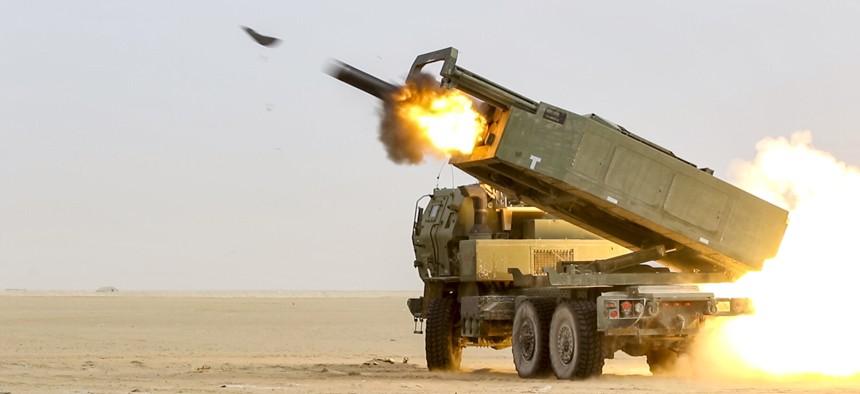
U.S. soldiers fire a High Mobility Artillery Rocket System during an exercise in Kuwait. Army Sgt. Bill Boecker
Army Secretary Reveals Weapons Wishlist for War with China & Russia
Army Secretary Mark Esper says he wants to shift money away from light vehicles and cargo helicopters made for “different conflicts” of the past.
U.S. Army leaders revealed Tuesday that they are briefing top military commanders about new weapons being built specifically for “high-intensity conflict” against China and Russia, in a new effort to assure that they could provide vital firepower for those potential battlefields of the future.
Army Secretary Mark Esper said he wants to shift some money away from vehicles and aircraft more suited for conflicts in Afghanistan and Iraq and into “what I need to penetrate Russian or Chinese air defenses.”
Among the new weapons and technologies he said are critical: long-range artillery, attack and reconnaissance aircraft, air and missile defenses, and command-and-control networks. Esper said the artillery — known as Long-Range Precision Fires — could be used “to hold at bay Chinese ships.”
Army officials recently briefed Adm. Philip Davidson, commander of U.S. Indo-Pacific Command, who oversees all U.S. military personnel in the Asia-Pacific region. This comes as the Army plans to rotate thousands of soldiers on expeditionary deployments throughout the Pacific — an expansive region often associated with Navy and Air Force military operations.
“We want to talk to [U.S. European Command] as well,” Esper said. “What we’re trying to do is go out and tell them what we’re doing.”
Last year, the Army held a series of reviews that recommended cutting or reducing nearly 200 weapons projects, freeing up $25 billion for investment in higher-priority programs. Among the projects cut are upgrades to Boeing-made CH-47 Chinook helicopters and buys of Oshkosh-made Joint Light Tactical Vehicles, the Army’s replacement for Humvees. Esper said he needs to shift money into “Future Vertical Lift,” an effort to build faster helicopters and tilt-rotor aircraft — similar to the V-22 Osprey — instead of upgrades to older, larger, and slower helicopters.
“What I don’t have right now is an attack/reconnaissance aircraft,” Esper said, Tuesday during a briefing at the Pentagon. “That’s what I need to penetrate Russian or Chinese air defenses. I’m not going to do that with a CH-47.”
The Army is evaluating prototypes built by Bell and a Lockheed Martin-Boeing team, as it determines the makeup of a new generation of military helicopters.
Army leaders plan to cut the number of Joint Light Tactical Vehicles they will buy from Oshkosh but the size of the reduction has not been finalized, Esper said. Army Undersecretary Ryan McCarthy has previously said the service plans to cut 1,900 vehicles.
“We are certainly cutting the total number. I know that much,” Esper said. “But whether it ... finals out; right here today, I can’t tell you. In five years, I could maybe have a different number for you.”
The secretary said that they decision to buy Chinooks and JLTVs was made before the Trump administration’s January 2018 National Defense Strategy put the Pentagon on a path to preparing for great power competition with Russia and China. That strategy reduced the Defense Department’s priority on counterterrorism and counterinsurgency fights in Afghanistan, Iraq, and other spots like Syria, which had dominated much of the past two decades. In its wake, the Army is building new doctrine that will be evaluated over the next 12 to 18 months. The results of those wargames will determine how many soldiers and weapons are needed in the future.
“They were in many ways designed for a different conflict,” he said, of Chinooks and JLTVs. “It doesn’t mean we won’t use them in future conflicts, but now my emphasis has to be on rebuilding my armor, rebuilding my fighting vehicles, having aircraft that can penetrate Russia and Chinese air defenses, that can shoot down Russian and Chinese drones and missiles and helicopters and fixed-wing aircraft. We’re in this transition period and so some folks are caught in that transition.”
Related podcast:





